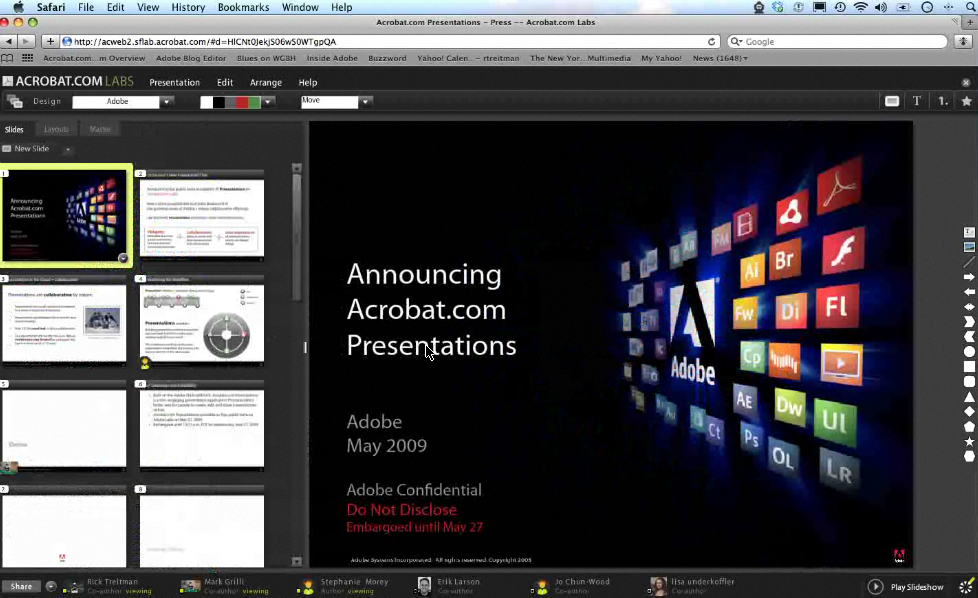Acrobat.com release "PowerPoint for the web"

This post was under embargo until 12:01am today, which makes it around 5am in London. Zack Whittaker is sleeping away in mere ignorance of this post going live, so any edits will be made when he wakes up... at 3pm.
Within the last few minutes, Adobe Acrobat.com Labs have released Presentations, an online presentation tool which rivals that of the PowerPoint web application.
As Office web applications, part of Office 2010, are slowly being developed in the background under the shroud of Microsoft's iron curtain, Adobe are marching forwards with their online office suite - aimed at those who work on the web, in the cloud, and from multiple locations.
As students have multiple machines to work with; at home, on campus and their laptops, it makes sense to work on the web on certain things. The difference between the web and desktop also makes it hard to tell the difference in changes when working collaboratively. Plus, if for whatever reason you're working on something in different timezones, you'll find that working collaboratively anyway is pretty difficult.
The magic juice behind the web software, as with the rest of the suite, including Buzzword, the Word equivalent, is that it uses Flash to render everything you see on the screen; unlike Google Docs which uses xHTML and AJAX technology. As a result, it can be run on any computer or mobile device, on any platform in any browser as Flash is open to every client possible. Also, after playing with it for some time already, it uses "spot-on-WYSIWIG", so it exports and prints exactly as you see it on the screen.
An interesting development is the exposé designer at the bottom, in a Mac-style dock bar which enables you to switch slides easily. No more will you have to end your presentation, select the slide you want, then restart your presentation.
If you have multiple people working on the same document, forget emailing it backwards and forwards. If you have a presentation which you need to give as part of a group, you can all work on it at the same time - a feature which does not exist in PowerPoint 2010. Each user has their own avatar which is displayed on the slide that person is working on, therefore freezing the slide to only that user. This concept of "user presence" is something that can only really be applied to an online web application, and something which Adobe has done well.
After speaking to the guys at Acrobat.com last week, they told me that Presentations is only at 40% whereas PowerPoint would stand at 100%. It's not complete yet and many bits are missing; access permissions, no tables or charts and no clip-art to speak of. It's simply a "proof-of-concept" which is basic enough to use, but advanced enough to rival that of PowerPoint, let alone other online presentation software's.
What makes it unique, however, is what makes Buzzword different. The rendering of the fonts and the inter-character spacing, and the overall control and look of the slides can't be done in HTML. The only way in which you can do it on a non-desktop system is to use Flash, Silverlight, or similar. The end result is far more qualitative.
In due time, the Flash format will be slowly dissolved and Adobe AIR will roll into action. This will allow synchronisation between the desktop, shifting the web application from a Software-as-a-Service to a Software+Services design.
Movies, specifically those in .flv format and much more media formats later on, can be embedded easily into your presentations. All Microsoft formats will be supported and if the need is wanted by users, there is no prevention from bringing in any file type they want.
Finally, as most presentation software on the web is "read-only", allowing you to import your slides in and present from anywhere, Presentation is write allowed, allowing you to import, edit, create and export again. At the moment you can only export into PDF, but over time it will export to all Buzzword formats (including .doc, .docx, .xml, .rtf, .zip, .txt, .odf and .epub) as well as PowerPoint 2003/2007 formats.
Go and have a play with the software. What do you think?
